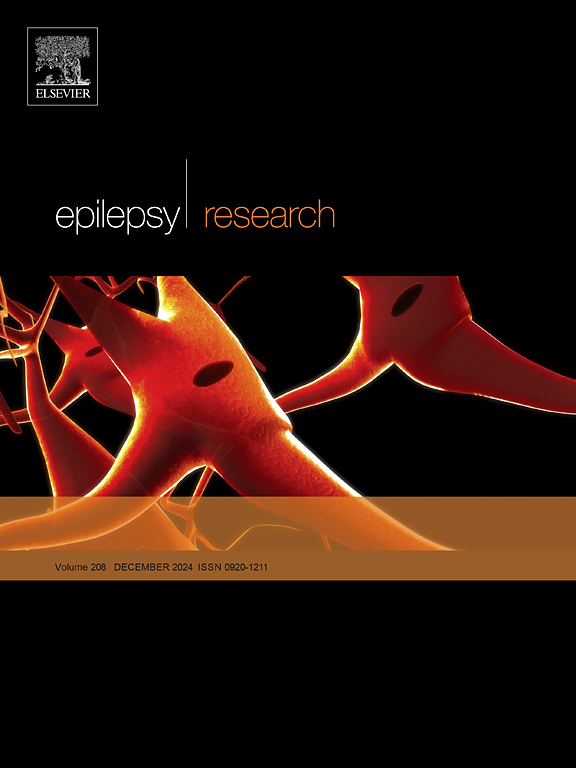丘脑皮质回路的动态功能连接变异性:来自具有中央颞叶尖峰(SeLECTs)的自限性癫痫的见解
IF 2
4区 医学
Q3 CLINICAL NEUROLOGY
引用次数: 0
摘要
自限性癫痫伴中央颞叶尖峰(SeLECTs)是一种主要的儿童癫痫形式,其特征是癫痫发作起源于大脑的中央颞叶区。至关重要的是,揭示select的神经动力学和机制为有效的诊断和治疗策略铺平了道路。我们的工作研究了select个体丘脑皮质回路中的动态功能连接(dFC)变异性,从而揭示了与癫痫发作和传播相关的连接模式的时间动态和异常。方法利用来自45名select患者和55名健康对照(hc)的静息状态功能磁共振成像(rs-fMRI)数据,检测不同脑区功能连接(FC)随时间的动态变化。我们选择了16个丘脑种子,使用滑动窗口方法深入研究dFC变异性。我们还评估了两组的临床数据,以确定其与dFC变异性的相关性。作为最后一步,使用支持向量机(SVM)进行分类分析,以证明dFC变异性作为select患者和hc患者之间的区分特征的潜在用途。结果检验分析表明,与丘脑种子相关的select组和hc组之间的dFC变异性存在显著差异,也显示了VCI与某些区域之间的相关性。在16个丘脑种子中,有9个种子出现了显著差异。具体来说,在select患者中,观察到右侧枕部丘脑种子和右侧中央前回之间的dFC变异性增加,这意味着积极的连通性改变。另一方面,在右侧前额下丘脑种子和左侧楔叶之间观察到较低的dFC,反映了它们连接强度的降低。结论我们的研究强调了在select个体的丘脑皮质回路中dFC变异性的重要性。明显的异常连接模式丰富了我们对与select发作发生和传播相关的时间动力学的理解,从而有助于理解select的病理生理。这些见解可能指导针对这种广泛存在的儿童癫痫的精确诊断和治疗策略的发展。本文章由计算机程序翻译,如有差异,请以英文原文为准。
Dynamic functional connectivity variability in the thalamocortical circuit: Insights from Self-Limited Epilepsy with Centrotemporal Spikes (SeLECTs)
Background
Self-Limited Epilepsy with Centrotemporal Spikes (SeLECTs) is a dominant childhood epilepsy form characterized by seizures originating from the brain’s centrotemporal region. Crucially, unlocking the neural dynamics and mechanisms underlying SeLECTs paves the way for potent diagnostic and therapeutic strategies. Our work investigates dynamic functional connectivity (dFC) variability in the thalamocortical circuit in SeLECTs individuals, thereby shedding light on the temporal dynamics and anomaly in connectivity patterns tied to seizure occurrence and propagation.
Methods
Utilizing resting-state functional magnetic resonance imaging (rs-fMRI) data from 45 SeLECTs patients and 55 healthy controls (HCs), dynamic changes in functional connectivity (FC) across various brain regions were examined over time. We selected 16 thalamic seeds to delve into dFC variability using a sliding window approach. We also evaluated clinical data from both groups to discern its correlation with dFC variability. As a final step, a Support Vector Machine (SVM) was employed for classification analysis to demonstrate the potential use of dFC variability as a distinguishing feature between SeLECTs patients and HCs.
Results
t-test analysis manifested significant variances in dFC variability between SeLECTs and HCs groups related to thalamus seeds, also showing a correlation between VCI and certain areas. Out of 16 thalamus seeds, significant variances emerged in 9 seeds. Specifically, an increase in dFC variability was observed between the right occipital thalamus seed and the right precentral gyrus in SeLECTs patients, implying a positive connectivity alteration. On the other hand, a lowered dFC was observed between the right inferior prefrontal thalamus seed and the left cuneus, reflecting a reduction in their connectivity strength.
Conclusion
Our study underscores the significance of dFC variability within the thalamocortical circuit in SeLECTs individuals. The noticeable aberrant connectivity patterns enrich our understanding of temporal dynamics linked to SeLECTs seizure occurrence and propagation, thereby contributing to understanding SeLECTs pathophysiology. These insights may steer the development of precise diagnostic and therapeutic strategies for this widespread childhood epilepsy.
求助全文
通过发布文献求助,成功后即可免费获取论文全文。
去求助
来源期刊

Epilepsy Research
医学-临床神经学
CiteScore
0.10
自引率
4.50%
发文量
143
审稿时长
62 days
期刊介绍:
Epilepsy Research provides for publication of high quality articles in both basic and clinical epilepsy research, with a special emphasis on translational research that ultimately relates to epilepsy as a human condition. The journal is intended to provide a forum for reporting the best and most rigorous epilepsy research from all disciplines ranging from biophysics and molecular biology to epidemiological and psychosocial research. As such the journal will publish original papers relevant to epilepsy from any scientific discipline and also studies of a multidisciplinary nature. Clinical and experimental research papers adopting fresh conceptual approaches to the study of epilepsy and its treatment are encouraged. The overriding criteria for publication are novelty, significant clinical or experimental relevance, and interest to a multidisciplinary audience in the broad arena of epilepsy. Review articles focused on any topic of epilepsy research will also be considered, but only if they present an exceptionally clear synthesis of current knowledge and future directions of a research area, based on a critical assessment of the available data or on hypotheses that are likely to stimulate more critical thinking and further advances in an area of epilepsy research.
 求助内容:
求助内容: 应助结果提醒方式:
应助结果提醒方式:


